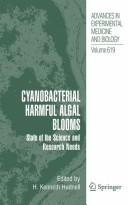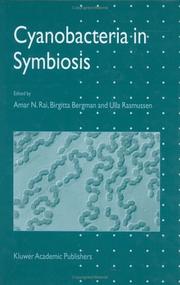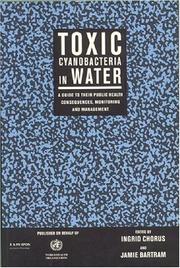| Listing 1 - 4 of 4 |
Sort by
|

ISBN: 1281242306 9786611242305 0387758658 038775864X Year: 2008 Publisher: New York : Springer,
Abstract | Keywords | Export | Availability | Bookmark
 Loading...
Loading...Choose an application
- Reference Manager
- EndNote
- RefWorks (Direct export to RefWorks)
Cyanobacteria are single-celled organisms that live in fresh, brackish, and marine water. They use sunlight to make their own food. In warm, nutrient-rich environments, microscopic cyanobacteria can grow quickly, creating blooms that spread across the water’s surface and may become visible. Because of the color, texture, and location of these blooms, the common name for cyanobacteria is blue-green algae. However, cyanobacteria are related more closely to bacteria than to algae. Cyanobacteria are found worldwide, from Brazil to China, Australia to the United States. In warmer climates, these organisms can grow year-round. Scientists have called cyanobacteria the origin of plants, and have credited cyanobacteria with providing nitrogen fertilizer for rice and beans. But blooms of cyanobacteria are not always helpful. When these blooms become harmful to the environment, animals, and humans, scientists call them cyanobacterial harmful algal blooms (CyanoHABs). Freshwater CyanoHABs can use up the oxygen and block the sunlight that other organisms need to live. They also can produce powerful toxins that affect the brain and liver of animals and humans. Because of concerns about CyanoHABs, which can grow in drinking water and recreational water, the U.S. Environmental Protection Agency (EPA) has added cyanobacteria to its Drinking Water Contaminant Candidate List. This list identifies organisms and toxins that EPA considers to be priorities for investigation. Reports of poisonings associated with CyanoHABs date back to the late 1800's. Anecdotal evidence and data from laboratory animal research suggest that cyanobacterial toxins can cause a range of adverse human health effects, yet few studies have explored the links between CyanoHABs and human health. Humans can be exposed to cyanobacterial toxins by drinking water that contains the toxins, swimming in water that contains high concentrations of cyanobacterial cells, or breathing air that contains cyanobacterial cells or toxins (while watering a lawn with contaminated water, for example). Health effects associated with exposure to high concentrations of cyanobacterial toxins include: stomach and intestinal illness; trouble breathing; allergic responses; skin irritation; liver damage; and neurotoxic reactions, such as tingling fingers and toes. Scientists are exploring the human health effects associated with long-term exposure to low levels of cyanobacterial toxins. Some studies have suggested that such exposure could be associated with chronic illnesses, such as liver cancer and digestive-system cancer. This monograph contains the proceedings of the International Symposium on Cyanobacterial Harmful Algal Blooms held in Research Triangle Park, NC, September 6-10, 2005. The symposium was held to help meet the mandates of the Harmful Algal Bloom and Hypoxia Research and Control Act, as reauthorized and expanded in December 2004. The monograph will be presented to Congress by an interagency task force. The monograph includes: 1) A synopsis which proposes a National Research Plan for Cyanobacteria and their Toxins; 2) Six workgroup reports that identify and prioritize research needs; 3) Twenty-five invited speaker papers that describe the state of the science; 4) Forty poster abstracts that describe novel research.
Algal blooms --- Cyanobacterial blooms --- Cyanobacterial toxins --- Health aspects. --- Prevention. --- Environmental aspects. --- Algae blooms --- Blooms, Algal --- Microalgal blooms --- Phytoplankton algal blooms --- Water bloom --- Water blooms --- Algal populations --- Microalgae --- Plankton blooms --- Blue-green algal toxins --- Cyanobacteria toxins --- Cyanotoxins --- Bacterial toxins --- Blooms, Cyanobacterial --- Cyanobacteria blooms --- Cyanobacteria --- Neurosciences. --- Neural sciences --- Neurological sciences --- Neuroscience --- Medical sciences --- Nervous system

ISBN: 1402007779 0306480050 9781402007774 Year: 2002 Publisher: Dordrecht : Springer Netherlands,
Abstract | Keywords | Export | Availability | Bookmark
 Loading...
Loading...Choose an application
- Reference Manager
- EndNote
- RefWorks (Direct export to RefWorks)
Cyanobacterial symbioses are no longer regarded as mere oddities but as important components of the biosphere, occurring both in terrestrial and aquatic habitats worldwide. It is becoming apparent that they can enter into symbiosis with a wider variety of organisms than hitherto known, and there are many more still to be discovered, particularly in marine environments. The chapters cover cyanobacterial symbioses with plants (algae, bryophytes, Azolla, cycads, Gunnera), cyanobacterial symbioses in marine environments, lichens, Nostoc-Geosiphon (a fungus closely related to arbuscular mycorrhiza fungi) symbiosis, and artificial associations of cyanobacteria with economically important plants. In addition, cyanobiont diversity, sensing-signalling, and evolutionary aspects of the symbiosis are dealt with. Renowned experts actively involved in research on cyanobacterial symbioses deal with ecological, physiological, biochemical, molecular, and applied aspects of all known cyanobacterial symbioses. This volume on cyanobacteria in symbiosis complements the two earlier volumes on cyanobacteria published by Kluwer (Molecular Biology of Cyanobacteria, edited by D.A. Bryant and Ecology of Cyanobacteria, edited by B.A. Whitton and M. Potts). Together, the three volumes provide the most comprehensive treatment of cyanobacterial literature as a whole. The book will serve as a valuable reference work and text for teaching and research in the field of plant-microbe interactions and nitrogen fixation.
Cyanobacterial blooms. --- Cyanobacteria --- Symbiosis. --- Symbiosis --- Ecology. --- Ecology --- Cyanobacterial blooms --- Biology --- Health & Biological Sciences --- Microbiology & Immunology --- Consortism --- Symbiogenesis --- Bacteria, Blue-green --- Blue-green algae --- Blue-green bacteria --- Blue-greens (Microorganisms) --- Cryptophyceae --- Cyanochloronta --- Cyanophyceae --- Cyanophycota --- Cyanophyta --- Myxophyceae --- Myxophyta --- Phycochromophyceae --- Schizophyceae --- Prokaryotes --- Blooms, Cyanobacterial --- Cyanobacteria blooms --- Water bloom --- Water blooms --- Plankton blooms --- Cyanobacteria - Ecology. --- Cyanobacteria - Ecology

ISBN: 0419239308 9780419239307 Year: 2005 Publisher: London Taylor and Francis
Abstract | Keywords | Export | Availability | Bookmark
 Loading...
Loading...Choose an application
- Reference Manager
- EndNote
- RefWorks (Direct export to RefWorks)
574.5 --- 574.5 Hydrobiology. Aquatic biocoenoses and ecosystems. Food chains --- Hydrobiology. Aquatic biocoenoses and ecosystems. Food chains --- Cyanobacteria --- Cyanobacterial blooms --- Cyanobacterial toxins --- Drinking water --- Sanitary microbiology --- Blue-green algal toxins --- Cyanobacteria toxins --- Cyanotoxins --- Bacterial toxins --- Blooms, Cyanobacterial --- Cyanobacteria blooms --- Water bloom --- Water blooms --- Plankton blooms --- Bacteria, Blue-green --- Blue-green algae --- Blue-green bacteria --- Blue-greens (Microorganisms) --- Cryptophyceae --- Cyanochloronta --- Cyanophyceae --- Cyanophycota --- Cyanophyta --- Myxophyceae --- Myxophyta --- Phycochromophyceae --- Schizophyceae --- Prokaryotes --- Microbiology --- Cyanobacteria. --- Cyanobacterial blooms. --- Cyanobacterial toxins. --- Microbiology. --- Drinking water - Microbiology
Book
ISBN: 9789050112420 9050112420 9004277986 Year: 2006 Publisher: Utrecht : Koninklijke nederlandse natuurhistorische vereniging (KNNV).,
Abstract | Keywords | Export | Availability | Bookmark
 Loading...
Loading...Choose an application
- Reference Manager
- EndNote
- RefWorks (Direct export to RefWorks)
The Netherlands are a small country, characterized by a large diversity of fresh to slightly brackish, oligo- to hypereutrophic stagnant and flowing inland waters. This diversity is reflected in a remarkable richness of phytoplankton species with blue-green algae as an important component. Identification of phytoplankton frequently brings on serious problems, due to the scarcity of up-to-date floras. This book, written by an acknowledged Dutch phytoplankton expert, presents a new modern approach to the identification of phytoplankton of The Netherlands. • treats 95 species belonging to 23 genera of non-filamentous blue-green algae in the plankton of Dutch inland waters including one new genus and 15 new species • nomenclature according to modern insights and in agreement with international rules • 500 original black-and-white photographs show all the details necessary for light-microscopical identification • contains an identification key to the species and comparing every species to similar forms • information on ecology and occurrence in different water types • relevant literature references
Algae --- Flore. Botanic determination guides --- Netherlands --- 582.26 <492> --- 582.232 --- Algae. Bacillariophyta (Diatomeae). Seaweeds etc.--Nederland --- Schizophyceae. Phycochromaceae. Cyanophyceae. Blue-green algae --- 582.232 Schizophyceae. Phycochromaceae. Cyanophyceae. Blue-green algae --- Cyanobacteria --- Cyanobacterial blooms --- Cyanobacteria. --- Cyanobacterial blooms. --- Blooms, Cyanobacterial --- Cyanobacteria blooms --- Water bloom --- Water blooms --- Bacteria, Blue-green --- Blue-green algae --- Blue-green bacteria --- Blue-greens (Microorganisms) --- Cryptophyceae --- Cyanochloronta --- Cyanophyceae --- Cyanophycota --- Cyanophyta --- Myxophyceae --- Myxophyta --- Phycochromophyceae --- Schizophyceae --- Prokaryotes --- Plankton blooms --- Netherlands. --- Austrian Netherlands --- Aynacha Jach'a Markanaka --- Batavia --- Belanda --- Beulanda --- Çheer Injil --- Çheer y Vagheragh --- Eben Eyong --- Háland --- Herbehereak --- Herbehereetako Erresumaren --- Hò-làn --- Holand --- Holanda --- Holandija --- Holandska --- Hōlani --- Holenda --- Holland --- Holland Királyság --- Hollandi --- Hollandia --- Hōrana --- Huēyitlahtohcāyōtl in Tlanitlālpan --- Huland --- Hulanda --- Iseldiroedd --- Iseldiryow --- Ísiltír --- Izelvroio --- Karaleŭstva Nidėrlandy --- Katō Chōres --- Kē-tē-kok --- Keninkryk fan 'e Nederlannen --- Kerajaan Landa --- Kéyah Wóyahgo Siʼánígí --- Keyatiya Nederlandan --- Kingdom of the Netherlands --- Koninkrijk der Nederlanden --- Konungsríkið Holland --- Kraljevina Holandija --- Kralojstwo Nederlandow --- Kralstvo Holandija --- Kralstvo Niderlandii͡ --- Landa --- Madalmaad --- Mamlakat Hūland --- Mamlekhet Artsot ha-Shefelah --- Nederilande --- Nederlaand --- Nederlân --- Nederland --- Nederlande --- Nederlandene --- Nederlandia --- Nederlando --- Nederlands --- Néderlandzk --- Nederlatt --- Nederlendin Nutg --- Nedŏlland --- Neerlande --- Nethiland --- Niadaland --- Niderland --- Niderland Krallığı --- Niderlanddar --- Niderlande --- Nīderlandeja --- Nīderlandes Karaliste --- Niderlandʺi͡as --- Niderlandʺi͡as Korolʹuv --- Niderlandii͡ --- Niderlandla --- Niderlandlany Korolevstvosu --- Niderlandsem --- Niderlandsen Patshalăkh --- Niderlandtæ --- Niderlandtar --- Niderlandtar Korollege --- Niderlandty Kʺarolad --- Niderlandy --- Niderlandyn Vant Uls --- Niðurlond --- Niederlande --- Nirlan --- Nižozemska --- Nizozemsko --- Nyderlandai --- Nyderlandų Karalyst --- Olanda --- Ollandia --- Oostenrijkse Nederlanden --- Oranda --- Oranda Ōkoku --- Ot͡si͡azorksshi Nederlatt --- Paes Bass --- Paesi Bassi --- Paîs Bas --- Pais Basse --- Países Baixos --- Países Bajos --- Países Baxos --- Paisis Bajus --- Països Baixos --- Paixi Basci --- Pajjiżi l-Baxxi --- Payis-Bâs --- Payises Bashos --- Pays-Bas --- Pays-Bas autrichiens --- Pays-Bas espagnols --- Pays-Bas méridionaux --- Peyiba --- Reeriaght ny Çheer Injil --- Reĝlando Nederlando --- Regni Nederlandiarum --- Regno del Paises Basse --- Regnu di i Paesi Bassi --- Reino di Hulanda --- Reino dos Países Baixos --- Ríocht na hÍsiltíre --- Royaume des Pays-Bas --- Southern Netherlands --- Spanish Netherlands --- The Netherlands --- Tìrean Ìsle --- Tlanitlālpan --- Ubuholandi --- Ubuhorandi --- Ufalme wa Nchi za Chini --- Uholanzi --- Ulanda --- Ulanna --- Vasileio tōn Katō Chōrōn --- Walanda --- Zuidelijke Nederlanden --- Algae, blue-green
| Listing 1 - 4 of 4 |
Sort by
|

 Search
Search Feedback
Feedback About UniCat
About UniCat  Help
Help News
News